车辆路径问题论文:规模动态增长的车辆路径优化问题
《医疗器械车辆路径优化问题的研究》范文
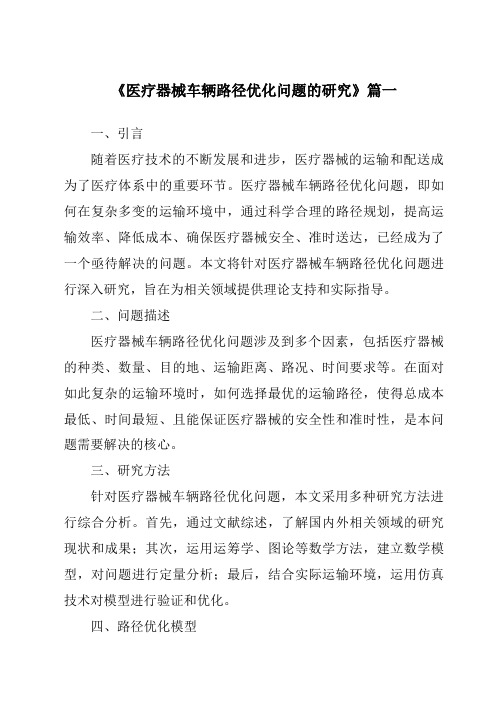
《医疗器械车辆路径优化问题的研究》篇一一、引言随着医疗技术的不断发展和进步,医疗器械的运输和配送成为了医疗体系中的重要环节。
医疗器械车辆路径优化问题,即如何在复杂多变的运输环境中,通过科学合理的路径规划,提高运输效率、降低成本、确保医疗器械安全、准时送达,已经成为了一个亟待解决的问题。
本文将针对医疗器械车辆路径优化问题进行深入研究,旨在为相关领域提供理论支持和实际指导。
二、问题描述医疗器械车辆路径优化问题涉及到多个因素,包括医疗器械的种类、数量、目的地、运输距离、路况、时间要求等。
在面对如此复杂的运输环境时,如何选择最优的运输路径,使得总成本最低、时间最短、且能保证医疗器械的安全性和准时性,是本问题需要解决的核心。
三、研究方法针对医疗器械车辆路径优化问题,本文采用多种研究方法进行综合分析。
首先,通过文献综述,了解国内外相关领域的研究现状和成果;其次,运用运筹学、图论等数学方法,建立数学模型,对问题进行定量分析;最后,结合实际运输环境,运用仿真技术对模型进行验证和优化。
四、路径优化模型为了解决医疗器械车辆路径优化问题,本文建立了一种基于多目标决策的路径优化模型。
该模型考虑了运输成本、运输时间、路况、医疗器械安全性和准时性等多个因素,通过加权求和的方式,将多目标决策转化为单目标优化问题。
在模型中,我们采用了遗传算法、模拟退火算法等智能优化算法,对问题进行求解。
五、实验与结果分析为了验证模型的可行性和有效性,我们进行了大量的实验。
实验结果表明,经过优化后的路径,总成本降低了约XX%,运输时间缩短了约XX%,且医疗器械的安全性和准时性得到了有效保障。
此外,我们还对模型中的各个因素进行了敏感性分析,发现某些因素(如路况、运输距离等)对优化结果的影响较大,需要在实际应用中给予重点关注。
六、实际应用与展望医疗器械车辆路径优化模型在实际应用中取得了显著的效果。
通过该模型,医疗机构可以更加高效地完成医疗器械的运输和配送任务,提高了医疗服务的质量和效率。
单车场大规模车辆路径优化问题研究
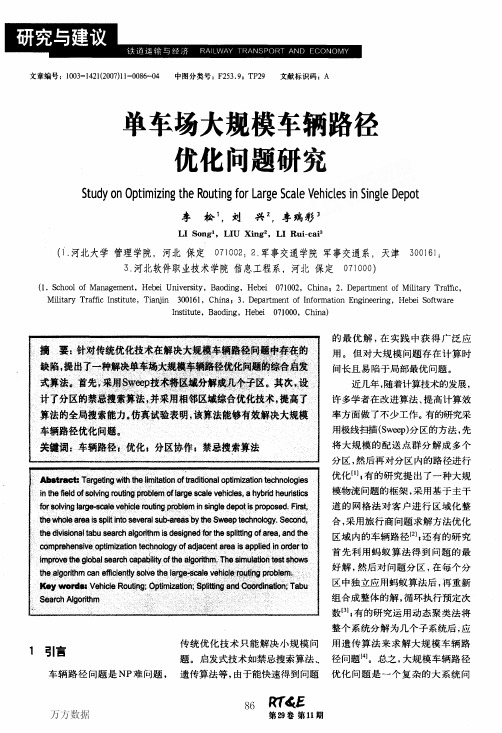
万方数据
单车场大规模车辆路径优化问题研究 李松等
量等于w×m(w为预先设计的每个 分区的运输车辆数,m为一辆车能 服务的最大配送点数量)时,形成 一个分区;继续扫过没有分配的配 送点,形成下一个分区;依次类推, 直到所有配送点被分成s个配送 点分区。
为了找到合适的分区方案,可 根据步骤2最优分区方案的选择 结果调整G的大小。其方法如下: 给G确定一个较小的自然数,并重 复算法中的步骤1和步骤2若干 次,如果每次选择的分区方案结果 稳定(相同或相近),则停止选择, 否则增加G的值,直到分区选择结 果稳定。 4.2分区内层改进禁忌搜索算法 4.2.1车辆一配送点分配结构模型
可以同时实现转库车辆指派和车辆路径的优化。实验结果表明,该模型和算法是解决该类问题的有效方法。本文着重对ILS的摄动和接受准则进行了分析
,根据它们对算法深度搜索和广度搜索的影响,设计出适合上述VRP问题的接受准则,并设计合理的算法流程,使接受准则和摄动能够很好的配合,达到
算法的整体优化。
本文还对以上问题进行了扩展,分析了具有异种车辆的钢铁企业产成品转库车辆指派及车辆路径优化问题。针对该问题的特点
铁道运输与经济 RAILWAY TRANSPORT AND ECONOMY 2007,29(11) 0次
参考文献(8条) 1.Renaud J.Boctor F A Sweep Based Algorithm for the Fleet Size and Mix Vehicle Routing Problem 2002(140)
2.学位论文 董国栋 钢铁企业产成品转库车辆路径问题建模与优化 2007
现代物流管理正在成为钢铁企业新的利润增长点,在钢铁企业取得竞争优势的战略中扮演重要角色。产成品转库管理作为钢铁企业物流管理的重要
《车辆路径问题求解算法分析2000字》
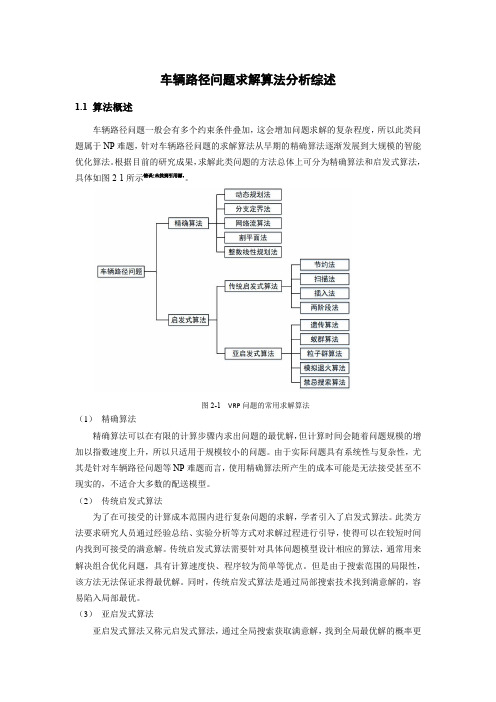
车辆路径问题求解算法分析综述1.1 算法概述车辆路径问题一般会有多个约束条件叠加,这会增加问题求解的复杂程度,所以此类问题属于NP难题,针对车辆路径问题的求解算法从早期的精确算法逐渐发展到大规模的智能优化算法。
根据目前的研究成果,求解此类问题的方法总体上可分为精确算法和启发式算法,具体如图2-1所示错误!未找到引用源。
图2-1VRP问题的常用求解算法(1)精确算法精确算法可以在有限的计算步骤内求出问题的最优解,但计算时间会随着问题规模的增加以指数速度上升,所以只适用于规模较小的问题。
由于实际问题具有系统性与复杂性,尤其是针对车辆路径问题等NP难题而言,使用精确算法所产生的成本可能是无法接受甚至不现实的,不适合大多数的配送模型。
(2)传统启发式算法为了在可接受的计算成本范围内进行复杂问题的求解,学者引入了启发式算法。
此类方法要求研究人员通过经验总结、实验分析等方式对求解过程进行引导,使得可以在较短时间内找到可接受的满意解。
传统启发式算法需要针对具体问题模型设计相应的算法,通常用来解决组合优化问题,具有计算速度快、程序较为简单等优点。
但是由于搜索范围的局限性,该方法无法保证求得最优解。
同时,传统启发式算法是通过局部搜索技术找到满意解的,容易陷入局部最优。
(3)亚启发式算法亚启发式算法又称元启发式算法,通过全局搜索获取满意解,找到全局最优解的概率更高。
此类算法是以自然界或人类社会中的一些智能现象为基础产生的,例如遗传算法源于自然界中生物的遗传、自然选择等进化规律,蚁群算法源于蚂蚁在觅食过程中的群体行为,粒子群算法源于鸟群的捕食行为,模拟退火算法源于热力学中固体的退火过程。
1.2 遗传算法(1)算法原理遗传算法是一种可以实现全局优化的自适应概率搜索算法,主要启于生物进化中“适者生存”的规律,即自然环境中适应能力越高的群体往往会产生更加优秀的后代。
通过模拟个体交叉和染色体基因突变等现象产生候选解,然后按照一定原则从中选择较优的个体,不断重复上述操作,直至得到达到终止条件的满意解。
物流车辆路径优化问题的研究
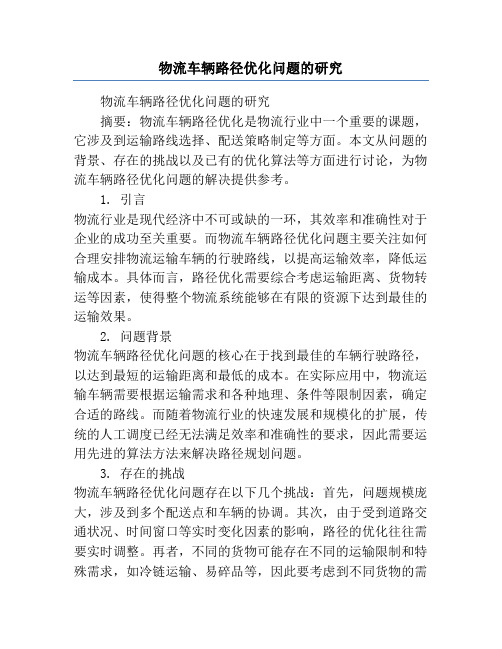
物流车辆路径优化问题的研究物流车辆路径优化问题的研究摘要:物流车辆路径优化是物流行业中一个重要的课题,它涉及到运输路线选择、配送策略制定等方面。
本文从问题的背景、存在的挑战以及已有的优化算法等方面进行讨论,为物流车辆路径优化问题的解决提供参考。
1. 引言物流行业是现代经济中不可或缺的一环,其效率和准确性对于企业的成功至关重要。
而物流车辆路径优化问题主要关注如何合理安排物流运输车辆的行驶路线,以提高运输效率,降低运输成本。
具体而言,路径优化需要综合考虑运输距离、货物转运等因素,使得整个物流系统能够在有限的资源下达到最佳的运输效果。
2. 问题背景物流车辆路径优化问题的核心在于找到最佳的车辆行驶路径,以达到最短的运输距离和最低的成本。
在实际应用中,物流运输车辆需要根据运输需求和各种地理、条件等限制因素,确定合适的路线。
而随着物流行业的快速发展和规模化的扩展,传统的人工调度已经无法满足效率和准确性的要求,因此需要运用先进的算法方法来解决路径规划问题。
3. 存在的挑战物流车辆路径优化问题存在以下几个挑战:首先,问题规模庞大,涉及到多个配送点和车辆的协调。
其次,由于受到道路交通状况、时间窗口等实时变化因素的影响,路径的优化往往需要实时调整。
再者,不同的货物可能存在不同的运输限制和特殊需求,如冷链运输、易碎品等,因此要考虑到不同货物的需求来确定合适的配送策略。
最后,优化算法需要综合考虑多个目标函数,如最短路径、最佳时间窗口等,并进行权衡和权重调整。
4. 已有的优化算法在解决物流车辆路径优化问题过程中,已经提出了许多优化算法。
其中,基于启发式搜索的算法是一种常用的方法,如模拟退火算法、遗传算法等。
这些算法能够通过合理的搜索策略来找到局部最优解。
另外,近年来,人工智能技术的快速发展也为物流车辆路径优化问题的解决带来了新的思路,如深度学习、强化学习等方法。
这些算法能够通过学习和优化来找到更加准确的路径规划方案。
5. 研究展望尽管已有的优化算法在一定程度上解决了物流车辆路径优化问题,但仍然存在一些挑战,如问题规模扩大时算法的效率问题,实时路径调整的问题,以及多目标函数的权衡问题等。
动态车辆路径优化问题
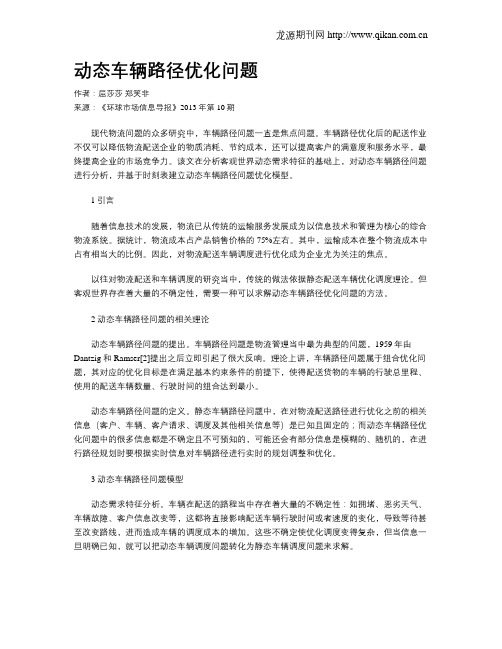
动态车辆路径优化问题作者:屈莎莎郑笑非来源:《环球市场信息导报》2013年第10期现代物流问题的众多研究中,车辆路径问题一直是焦点问题。
车辆路径优化后的配送作业不仅可以降低物流配送企业的物质消耗、节约成本,还可以提高客户的满意度和服务水平,最终提高企业的市场竞争力。
该文在分析客观世界动态需求特征的基础上,对动态车辆路径问题进行分析,并基于时刻表建立动态车辆路径问题优化模型。
1引言随着信息技术的发展,物流已从传统的运输服务发展成为以信息技术和管理为核心的综合物流系统。
据统计,物流成本占产品销售价格的75%左右。
其中,运输成本在整个物流成本中占有相当大的比例。
因此,对物流配送车辆调度进行优化成为企业尤为关注的焦点。
以往对物流配送和车辆调度的研究当中,传统的做法依据静态配送车辆优化调度理论。
但客观世界存在着大量的不确定性,需要一种可以求解动态车辆路径优化问题的方法。
2 动态车辆路径问题的相关理论动态车辆路径问题的提出。
车辆路径问题是物流管理当中最为典型的问题,1959年由Dantzig 和 Ramser[2]提出之后立即引起了很大反响。
理论上讲,车辆路径问题属于组合优化问题,其对应的优化目标是在满足基本约束条件的前提下,使得配送货物的车辆的行驶总里程、使用的配送车辆数量、行驶时间的组合达到最小。
动态车辆路径问题的定义。
静态车辆路径问题中,在对物流配送路径进行优化之前的相关信息(客户、车辆、客户请求、调度及其他相关信息等)是已知且固定的;而动态车辆路径优化问题中的很多信息都是不确定且不可预知的,可能还会有部分信息是模糊的、随机的,在进行路径规划时要根据实时信息对车辆路径进行实时的规划调整和优化。
3 动态车辆路径问题模型动态需求特征分析。
车辆在配送的路程当中存在着大量的不确定性:如拥堵、恶劣天气、车辆故障、客户信息改变等,这都将直接影响配送车辆行驶时间或者速度的变化,导致等待甚至改变路线,进而造成车辆的调度成本的增加。
《医疗器械车辆路径优化问题的研究》范文

《医疗器械车辆路径优化问题的研究》篇一一、引言随着医疗技术的不断发展和医疗需求的日益增长,医疗器械的运输与配送成为医疗体系的重要组成部分。
医疗器械车辆路径优化问题(Medical Equipment Vehicle Routing Problem,MEVRP)是物流与运输领域中一个重要的研究方向。
它涉及到如何高效、准确地为医疗机构配送医疗器械,以最小化成本和时间,满足医疗需求。
本文旨在探讨医疗器械车辆路径优化问题的相关研究,以期为解决现实中的问题提供理论支持和实践指导。
二、医疗器械车辆路径优化问题的背景与意义医疗器械的配送涉及多个环节,包括供应商、物流中心、配送中心以及医疗机构等。
在这个过程中,如何合理安排车辆路径,以提高配送效率、降低成本、保证医疗器械的及时供应,成为了一个亟待解决的问题。
医疗器械车辆路径优化问题的研究,对于提高医疗物流效率、降低医疗成本、保障患者就医体验具有重要意义。
三、医疗器械车辆路径优化问题的现状分析当前,医疗器械车辆路径优化问题面临着诸多挑战。
首先,医疗器械种类繁多,需求量差异大,导致配送需求复杂。
其次,医疗机构分布广泛,配送距离远近不一,对配送时效性要求高。
此外,道路交通状况、天气变化等因素也会对配送路径产生影响。
目前,相关研究主要集中在以下几个方面:1. 路径规划算法研究:包括启发式算法、遗传算法、模拟退火算法等,旨在寻找最优的配送路径。
2. 考虑不确定因素的路径优化:如考虑交通拥堵、天气变化等因素,建立动态路径优化模型。
3. 多目标优化:如同时考虑成本、时间、服务质量等多个目标,寻求综合最优的解决方案。
四、医疗器械车辆路径优化问题的研究方法针对医疗器械车辆路径优化问题,可以采用多种研究方法。
首先,可以通过建立数学模型,运用运筹学、物流学等相关理论,对问题进行量化分析。
其次,可以采用仿真方法,通过模拟实际场景,对不同路径方案进行测试和评估。
此外,还可以运用大数据、云计算等技术,对历史数据进行分析和预测,为路径优化提供支持。
车辆行驶路径规划与优化算法研究
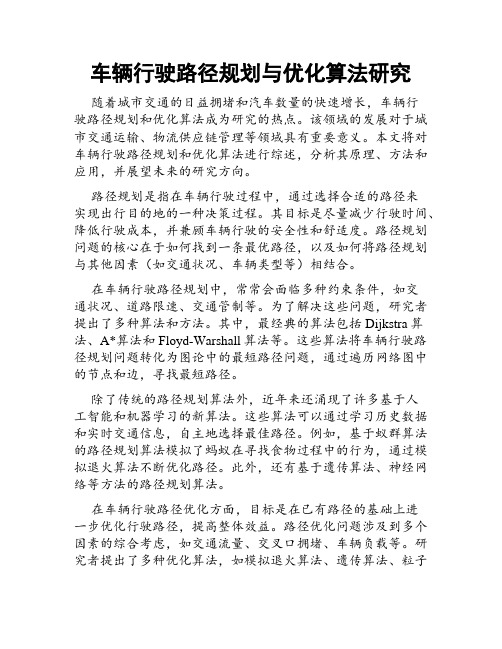
车辆行驶路径规划与优化算法研究随着城市交通的日益拥堵和汽车数量的快速增长,车辆行驶路径规划和优化算法成为研究的热点。
该领域的发展对于城市交通运输、物流供应链管理等领域具有重要意义。
本文将对车辆行驶路径规划和优化算法进行综述,分析其原理、方法和应用,并展望未来的研究方向。
路径规划是指在车辆行驶过程中,通过选择合适的路径来实现出行目的地的一种决策过程。
其目标是尽量减少行驶时间、降低行驶成本,并兼顾车辆行驶的安全性和舒适度。
路径规划问题的核心在于如何找到一条最优路径,以及如何将路径规划与其他因素(如交通状况、车辆类型等)相结合。
在车辆行驶路径规划中,常常会面临多种约束条件,如交通状况、道路限速、交通管制等。
为了解决这些问题,研究者提出了多种算法和方法。
其中,最经典的算法包括Dijkstra算法、A*算法和Floyd-Warshall算法等。
这些算法将车辆行驶路径规划问题转化为图论中的最短路径问题,通过遍历网络图中的节点和边,寻找最短路径。
除了传统的路径规划算法外,近年来还涌现了许多基于人工智能和机器学习的新算法。
这些算法可以通过学习历史数据和实时交通信息,自主地选择最佳路径。
例如,基于蚁群算法的路径规划算法模拟了蚂蚁在寻找食物过程中的行为,通过模拟退火算法不断优化路径。
此外,还有基于遗传算法、神经网络等方法的路径规划算法。
在车辆行驶路径优化方面,目标是在已有路径的基础上进一步优化行驶路径,提高整体效益。
路径优化问题涉及到多个因素的综合考虑,如交通流量、交叉口拥堵、车辆负载等。
研究者提出了多种优化算法,如模拟退火算法、遗传算法、粒子群算法等。
这些算法通过多次迭代和优化,不断更新路径,并逐步优化路径的效果。
路径规划和优化算法在实际应用中广泛应用于交通运输、物流配送等领域。
例如,通过合理的路径规划和优化,可以降低物流成本、提高交通效率,减少能源消耗和环境污染。
同时,也可以提高城市交通的安全性和便利性,提升居民的出行体验。
货物运输车辆路径方案优化

货物运输车辆路径方案优化在物流运输中,通过优化货物运输车辆的路径方案可以降低运输成本,提高运输效率。
因此,针对货物运输车辆路径方案的优化问题,研究如何提高运输效益具有重要意义。
优化问题的背景货物运输车辆路径方案的优化问题,是一个NP难问题。
这意味着,随着货物数量的增加,问题的复杂度呈指数级增长。
因此,如何寻找高效的算法,求解大规模问题,成为该问题研究的重点。
以往的解决方法主要基于启发式算法,如模拟退火、遗传算法等。
这些方法在求解规模较小的问题时效果较好。
但当问题规模达到一定程度时,这些启发式算法的效率也就随之降低。
近年来,随着分布式计算和并行计算等技术的发展,解决大规模货物运输车辆路径方案优化问题的效率得到了极大提高。
优化思路为了解决货物运输车辆路径方案优化问题,我们可以采用遗传算法等种群智能算法或线性规划等最优化算法。
在此,我们重点介绍遗传算法的思路。
遗传算法是一种仿生优化算法,常用于解决优化问题。
算法从初始种群中选取某些个体进行“交叉”、“变异”、“选择”等操作,逐步生成更好的种群,最终找到最优解。
在货物运输车辆路径方案优化问题中,遗传算法一般的操作步骤如下:1.设计评价函数。
评价函数需要量化不同方案的优劣,为算法提供方向。
2.创建初始种群。
初始种群从可行解空间中进行随机抽样,保证多样性。
3.选择操作。
选择优秀的个体保证下一代中所包含的优秀基因,同时避免早熟。
4.交叉操作。
选出优秀的个体对其进行基因交换,产生新的个体。
5.变异操作。
针对新个体中的某些基因进行变异,增加基因多样性,避免陷入局部最优解。
6.更新种群。
将新的种群作为下一代继续进行选择、交叉、变异等操作。
7.终止条件。
当算法迭代到一定次数或达到某种要求时,停止迭代,输出最优解。
通过遗传算法的迭代,我们可以逐步找到最优的货物运输车辆路径方案。
优化实践以下是以遗传算法为例,对货物运输车辆路径方案进行优化的具体实践步骤:1. 设计评价函数我们需要设计一个合适的评价函数,来衡量不同路径方案的优劣。
- 1、下载文档前请自行甄别文档内容的完整性,平台不提供额外的编辑、内容补充、找答案等附加服务。
- 2、"仅部分预览"的文档,不可在线预览部分如存在完整性等问题,可反馈申请退款(可完整预览的文档不适用该条件!)。
- 3、如文档侵犯您的权益,请联系客服反馈,我们会尽快为您处理(人工客服工作时间:9:00-18:30)。
车辆路径问题论文:规模动态增长的车辆路径优化问题【中文摘要】随着中国经济的快速发展,中国零售业在过去十几年来也得到了迅速发展,开始呈现蜂群式特征,即在区域内门店数量越来越多、单店业务量小,但总需求量大。
伴随不断扩大的企业规模和迅速扩张的店铺数量,使得零售物流成本持续增长。
如何在满足所有店铺的配送请求前提下,有效控制并缩减物流成本,提升企业盈利能力,从而在激烈的市场竞争中脱颖而出,几乎是所有零售业管理者不得不直面的挑战。
本文研究在这种新形势下的配送车辆路径安排问题,并根据其门店数的发展变化特征将其定义为规模动态增长的车辆路径优化问题。
文章分别从配送网络的网点分布、现实约束、规模动态增长特性以及优化目标等不同层面展开详细介绍从零售企业实践中抽象而来的规模动态增长的车辆路径优化问题。
建立以最小化配送费用、最大化不同场次线路间的相似性为目标的运筹优化模型,该模型考虑了运输网络规模大且带有不确定性不断增长的特点。
并提出基于经验划分的三阶段启发式算法来解决规模动态增长的车辆路径优化问题,并用JAVA实现其核心的C-W节约算法和禁忌搜索算法。
第一阶段,依据经验将大规模的车辆路径问题所覆盖的配送网络按照合适的原则划分成多个子配送区域,从而降低问题规模。
第二阶段,对所有子配送区域的所有配送点,采用C-W节约算法产生初始解,并调用禁忌搜索算法优化初始解,形成配送线路方案,即主线路模板。
第三阶段,每天,在收到当天需要配送的配送点及需求量等信息后,在主线路模板基础上,采用C-W节约算法将未出现在主线路模板上的配送点插入至最经济的位置、将线路模板上出现而未有需求的配送点直接剔除,形成每日配送路线方案的初始解;再采用禁忌搜索算法对初始解进行优化而形成最终的每日配送线路方案。
因此,本文的研究目标不仅仅是一次配送线路的成本最小化,而是在整个考虑的时间段内每次配送线路成本总和的最小化。
本文要解决的车辆路径优化问题来源于企业实践,是大规模的VRP问题,要求能够快速求解,并且能将优化的结果用来指导企业实践,因此要求优化解是可行并且可操作的。
因此本文结合企业现有资源,基于经验划分的三阶段启发式算法的实现情况向外拓展,设计简单易用合适的人机交互系统来优化并记录配送线路。
企业实践的结果显示模型和算法是高效且可行的。
【英文摘要】With the rapid economic development in China, the retail industry has developed tremendously in the past decade, and presents colony type characteristics, i.e., the number of stores is increasing, the orders per store is small but the total demand is large. To gain the benefit of the economies of scale, usually a unified distribution center serves all the stores in a region. With the transportation cost taking up to 50 percentage of the whole distribution cost, it is important to reduce the transportation cost which makes the vehicle routing problem crucial in the real business practice. This thesis studies the new problem which we called dynamicvehicle routing problem with an increasing scale (DIS-VRP), i.e., the number of stores is more than one thousand and keeps increasing stochastically.Increase in the number of stores makes the route change every day. However, the driver familiarity with routes and customers conduces to less service time, error and exceptional cost. Also for many other practical reasons, it’s beneficial to control route adjustment by creating regular or consistent routes for the DIS-VRP that assign the same driver to the set of customers to serve them through the same routes. Such consistent routes are easy to adapt to the realization of the daily uncertainty and help logistics improve the service quality.We propose a mixed integer programming formulation for the DIS-VRP, and develop an efficient three-phase heuristic algorithm based on customers cluster and Clarke & Wright and Tabu search. The model represents the uncertainty in stores changing and includes a master plan problem using all the customers at the beginning of period. The master plan routes are created without considering the similarity. After receiving distribution job, the daily schedules obtaining from the master routes are improved using a Tabu search algorithm.The scheme is implemented on real-life data. Application results show thatthe proposed three-phase heuristic provides high quality solutions within a reasonable running time.【关键词】车辆路径问题规模动态增长路线相似性经验划分零售【备注】索购全文在线加好友:1.3.9.9.3.8848同时提供论文写作一对一指导和论文发表委托服务【英文关键词】Vehicle routing problem Scale increasing Route consistent Tabu search Retail【目录】规模动态增长的车辆路径优化问题摘要5-6Abstract6第1章绪论9-18 1.1 选题背景和选题意义9-10 1.1.1 选题背景9-10 1.1.2 选题意义10 1.2 国内外研究现状综述10-15 1.2.1 车辆路径问题的模型研究现状10-12 1.2.2 车辆路径问题的算法研究现状12-15 1.3 本文工作15-18 1.3.1 研究背景15-16 1.3.2 主要研究内容16 1.3.3 论文安排16-18第2章物流配送中车辆路径优化问题研究综述18-30 2.1 物流配送概述18-22 2.1.1 物流概述18-19 2.1.2 配送概述19-21 2.1.3 配送线路21-22 2.2 车辆路径问题的描述22-26 2.2.1 文字描述22-25 2.2.2 数学模型25-26 2.2.3 求解复杂性分析26 2.3 车辆路径问题(VRP)的求解方法26-30 2.3.1 禁忌搜索算法原理简介27-28 2.3.2禁忌搜索算法运算流程28-30第3章规模动态增长的车辆路径优化问题30-37 3.1 网点分布30-31 3.2 现实约束31-33 3.3 规模动态增长33-34 3.4 优化目标34-37 3.4.1 运输成本34-36 3.4.2 前后线路一致性36-37第4章系统建模37-40 4.1 模型假设37 4.2 参数定义37-38 4.3 数学模型38-40第5章算法设计与实现40-51 5.1 基于经验的物流配送区域划分40-43 5.1.1 区域划分原理40-41 5.1.2 区域划分的影响因素分析41-43 5.2 C-W节约算法43-44 5.2.1 C-W节约算法描述43 5.2.2 C-W节约算法实现43-44 5.3 禁忌搜索算法设计分析与实现44-51 5.3.1 初始解44-45 5.3.2 邻域结构45-48 5.3.3 解的评价48 5.3.4 禁忌表48 5.3.5 终止准则48-49 5.3.6 禁忌搜索算法实现49-51第6章人机交互系统实现与案例研究51-56 6.1 人机交互系统实现与优化51-53 6.1.1 维护配送区域51-52 6.1.2 人工调整路线52-53 6.2 案例研究53-56 6.2.1 数据和参数53-54 6.2.2 灵敏度分析54-55 6.2.3 计算结果55-56第7章总结与展望56-587.1 结论56-577.2 展望57-58参考文献58-62致谢62-63攻读硕士期间发表的学术论文63攻读硕士期间参加的科研项目63。
